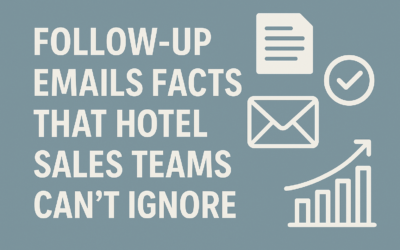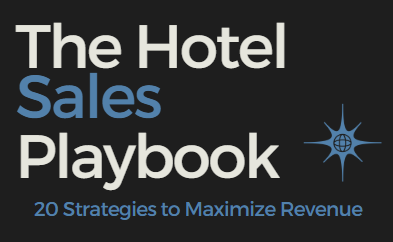TAILORING HOTEL PROPOSALS TO SPECIFIC MARKET SEGMENTS
March 19, 2024
The power of market segmentation is essential in proposal creation, where resonating with a specific audience can make or break a booking. When crafting proposals, appealing to the client and event planner is key.
In this blog, we’ll dive into the importance of hotel market segmentation, identifying its role in understanding client behaviors, and mastering the art of crafting effective targeted proposals.
The Importance of Hotel Market Segmentation
Market segmentation allows hotels to identify and target specific guests and groups, enhancing marketing efforts. By segmenting the market, hotels can tailor offerings and communication strategies to meet distinct needs and preferences. This strategy helps in:
Identifying Booking Patterns
Recognizing how groups engage in booking processes, preferred communication channels, and typical booking timings enables proactive outreach.
Boosting Client Satisfaction
Personalized experiences aligned with segment preferences lead to increased client satisfaction, fostering loyalty and enhancing the hotel’s reputation.
Maximizing Revenue
Understanding market dynamics helps predict revenue generation, optimizing resource allocation and maximizing bookings from profitable segments.
Standard segments include Transient, Corporate Negotiated, Wholesale, and Group, with focus on the latter, divided into MICE (Meetings, Incentives, Conventions, Exhibitions) and SMERF (Social, Military, Educational, Religious, Fraternal).
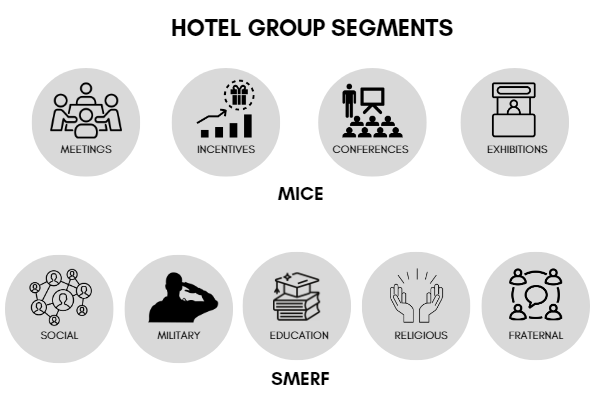
How to Tailor Proposals to Specific Market Segments
Tailoring proposals based on group segment and client preferences is essential—whether a concise document limited to pertinent information suffices or a comprehensive proposal with all the bells and whistles is more fitting. This personalized approach enhances the likelihood of meeting clients’ expectations and securing successful bookings.
TARGETED VISUALS
Images and other visual content play a crucial role in setting the tone for your proposal, capturing the attention of potential clients and helping them visualize their event experience. While you may have standard ‘hero shots’ that showcase your property’s features, it’s also beneficial to include past event photos that align with the type of event you’re bidding for, allowing planners to envision how their event could unfold in your space.
For SMERF proposals, consider incorporating lifestyle photos that resonate with their specific market, demonstrating your understanding of their unique needs and preferences.
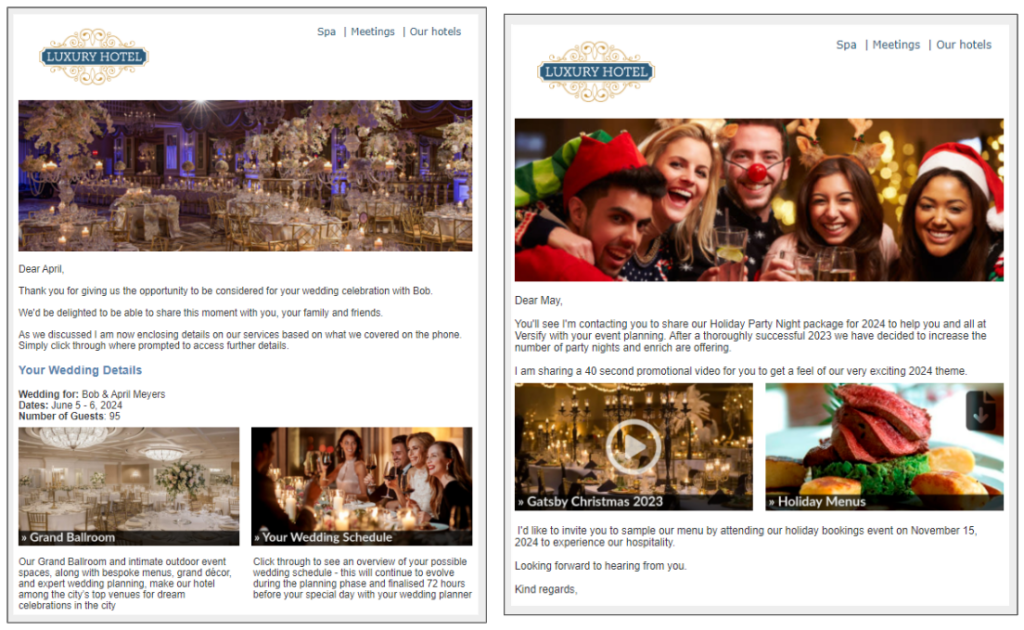
In addition to photographs, consider including maps highlighting your hotel’s location and its proximity to local restaurants and attractions, particularly for incentive groups. This provides valuable context for planners and attendees alike, showcasing the convenience and appeal of choosing your venue.
While visual content such as videos, floor plans, layouts, and 360-degree views can enhance your proposal, it’s advisable to link out to this content to maintain a clean and organized presentation. By decluttering the body of the proposal and directing readers to supplementary materials, you ensure that they can easily access additional information without overwhelming them with visual stimuli. This approach allows you to strike a balance between engaging visuals and concise, focused content, ultimately maximizing the impact of your proposal.
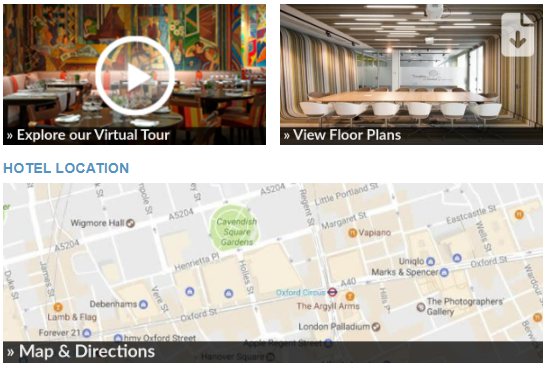
COMPELLING LAYOUT/DESIGN
The layout and design play an essential role in ensuring that your proposal is easy to read and understand, facilitating effective communication with your audience. While this principle applies to all proposals, tailoring the layout/design to the specific needs of different groups can enhance its effectiveness.
For MICE groups, incorporating charts and tables can be particularly beneficial for organizing complex information such as pricing options, event schedules, and venue capacities. These visual aids help to streamline the presentation of data, allowing planners to quickly compare options and make informed decisions.

On the other hand, proposals for SMERF groups may require a more narrative approach, with emphasis on detailed descriptions and storytelling to appeal to the group’s specific interests and priorities. Including “fluffy details” such as anecdotes, testimonials, and experiential descriptions can help to create a compelling narrative that resonates with the group’s values and objectives.
Regardless of the target audience, it’s important to maintain a clear and organized structure throughout the proposal. Use headings, subheadings, and bullet points to break up text and guide the reader through the document. Incorporate white space to improve readability and avoid overwhelming the reader with dense blocks of text.
RELEVANT KEY & SUPPORTING CONTENT
The key elements of your proposal serve as the foundation for each RFP response, providing essential information to potential clients. While certain components such as an introduction, proposed event space tables, room block details, cost summary, and next steps remain consistent across responses, it’s crucial to tailor these elements to the specific needs and priorities of each group.
When customizing your proposal, place greater emphasis on the main component that holds the most significance for the group. For example, if the primary focus is on the event itself, ensure that the event space options and related details are prominently featured. Alternatively, if accommodations are the main concern, highlight the room block options and amenities available.
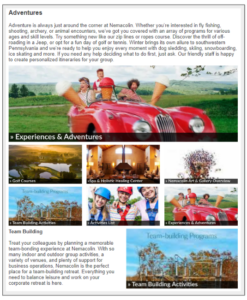
Supporting content should be tailored to the group type to address their specific interests and requirements. For conferences and conventions, provide comprehensive information on the surrounding area, including nearby attractions, transportation options, and dining establishments. Incentive groups will prioritize details about onsite amenities, services, and recreational activities that enhance the overall experience.
Meetings typically require detailed floor plans, layouts, and menu options to facilitate event planning and coordination. Additionally, for SMERF groups, menu options are a significant consideration, alongside the ability to accommodate unique requests and preferences. Including testimonials from similar SMERF groups can also help to build trust and credibility.
By customizing the content of your proposal to align with the priorities and preferences of each group type, you demonstrate your understanding of their needs and enhance the likelihood of securing their business. This tailored approach showcases your commitment to providing a personalized and exceptional experience for every client.
With UpMail, you gain access to our Template Inspiration Gallery, offering a selection of pre-designed templates tailored to different market segments and purposes.
To learn more, please email hello@upmailsolutions.com
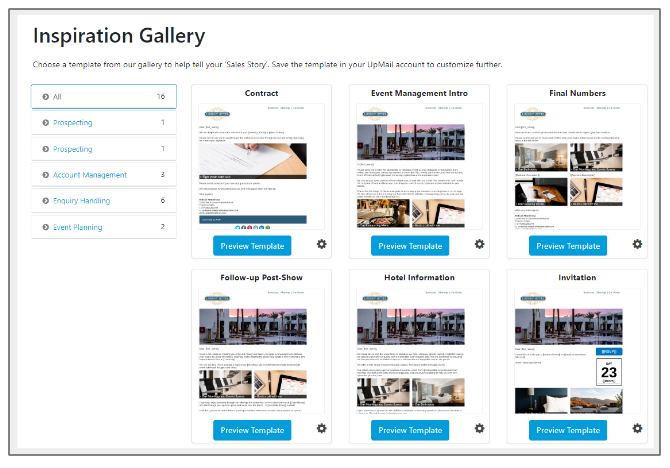
Follow-Up Email Facts That Hotel Sales Teams Can’t Ignore
Most hotel sales opportunities are lost not because of the offer—but because of a lack of follow-up. Let’s break down five facts that reveal just how crucial follow-ups are in both the prospecting and proposal stages of hotel sales.
The Hotel Sales Playbook: 20 Strategies to Maximize Revenue
Maximizing revenue in hotel sales requires a strategic approach to guestroom occupancy, upselling, and targeted promotions. By leveraging data from past inquiries and bookings, hotel sales teams can craft compelling offers that drive new business and maximize profitability. Here are 20 key strategies to help you increase revenue and optimize sales performance:
Give Your Hotel Sales Proposals an Edge with Unique, High-Impact Content
When it comes to hotel sales proposals, first impressions matter. A well-crafted proposal should do more than just present rates, dates and availability—it should tell a compelling story that resonates with your potential clients. Here are some key elements to consider including in your next hotel sales proposal to give it an edge.



